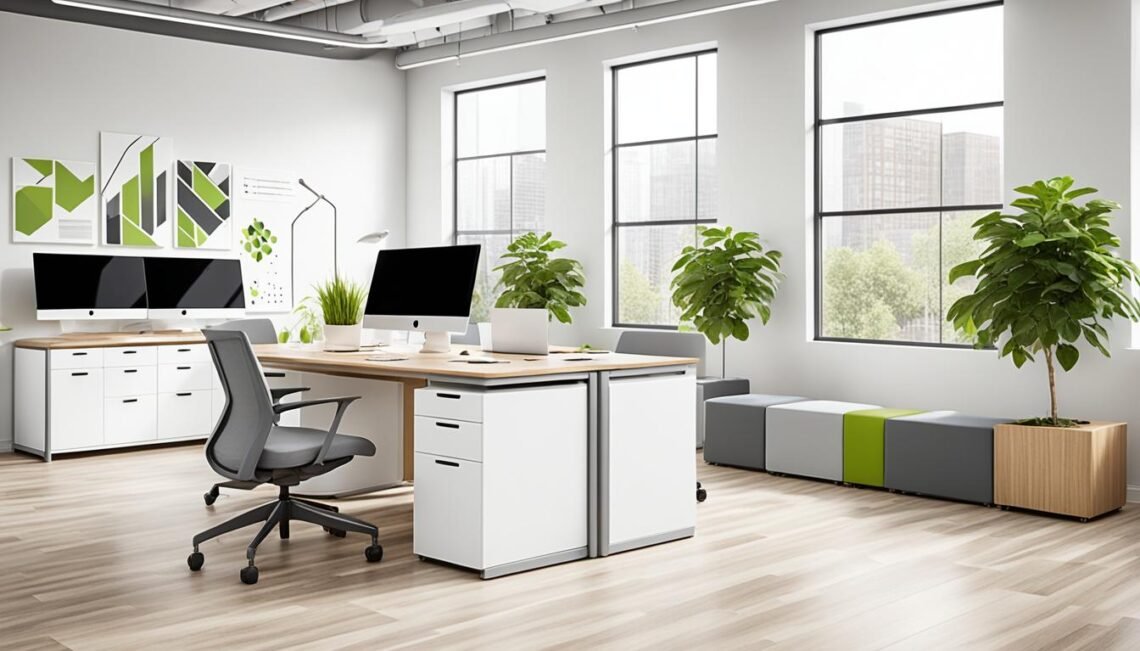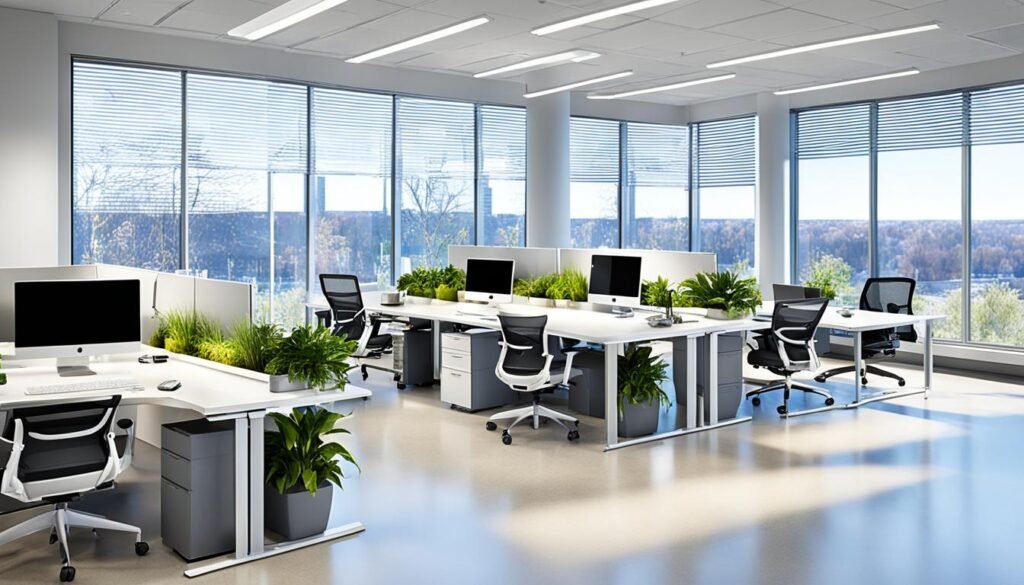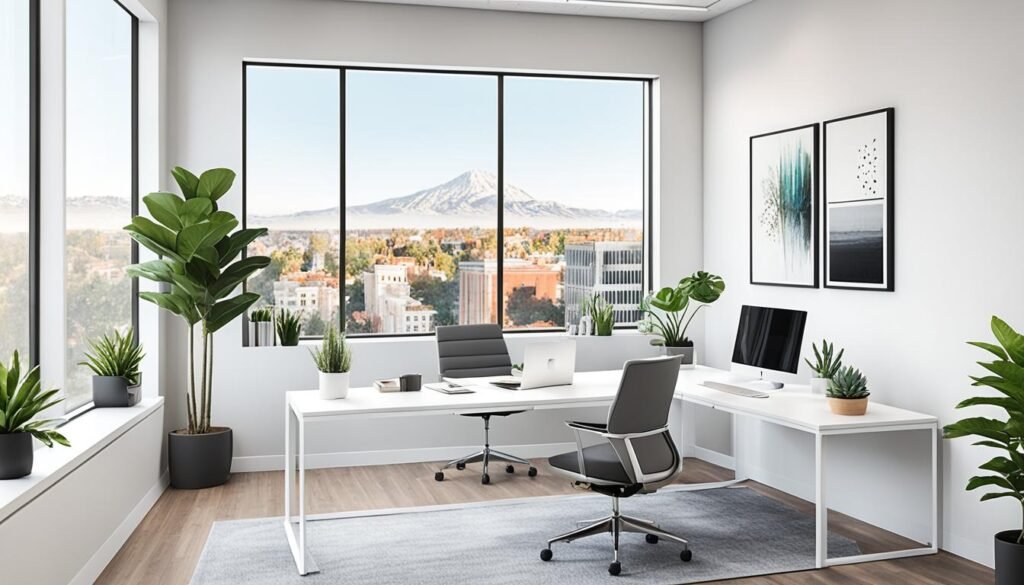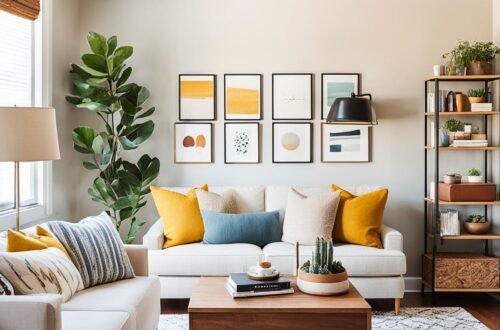
Fresh Office Interior Design Ideas for 2023
Welcome to our guide on the latest office interior design ideas for 2023. In this section, we will explore innovative solutions to enhance productivity and style in your workspace. Whether you’re looking to revamp your existing office or designing a new one, staying updated with the latest trends and incorporating them into your office design can have a significant impact on your employees’ morale, productivity, and overall well-being.
Key Takeaways:
- Stay up-to-date with the latest office interior design trends to create a modern and aesthetically pleasing workspace.
- Maximize limited office space with effective layout planning and design ideas specifically designed for small spaces.
- Prioritize ergonomic design elements to boost productivity and employee satisfaction.
- Create an office environment that fosters collaboration, teamwork, and effective communication among employees.
- Inspire and motivate employees by creating a welcoming and creative office atmosphere.
Office Interior Design Trends for 2023
Stay ahead of the curve with the hottest office interior design trends for 2023. As workspace aesthetics continue to evolve, it’s crucial for businesses to create a modern and visually appealing environment. Incorporating these design trends into your office can not only enhance the overall ambiance but also promote productivity and employee satisfaction.
Ergonomic Furniture
One of the key focuses in office interior design for 2023 is ergonomics. Ergonomic furniture designs prioritize the comfort and well-being of employees, ultimately promoting better posture, reducing strain, and improving overall work performance. Invest in adjustable desks and chairs that provide optimal support and flexibility, ensuring employees can maintain a healthy and comfortable working position.
Biophilic Design
Bringing elements of nature into the office is a growing trend in 2023. Biophilic design incorporates natural materials, greenery, and ample natural light to create a soothing and refreshing workspace. Consider adding plants, natural textures, and large windows to connect employees with the outdoors, improving their well-being and productivity.
Flexible and Collaborative Spaces
The traditional office layout is gradually making way for flexible and collaborative spaces. In 2023, office designs promote teamwork and communication by incorporating open plan layouts, multifunctional furniture, and dedicated areas for collaboration. These versatile spaces encourage interaction, creativity, and innovation among employees, fostering a sense of inclusivity and community.
Smart Technology Integration
Advancements in technology have revolutionized the workplace, and office interior design is no exception. Smart technology integration is a growing trend for 2023, enhancing efficiency and streamline processes. Incorporate smart features such as lighting control systems, automated climate control, and integrated communication tools to create a modern and connected workspace.
With the right combination of these office interior design trends, your workspace can transform into a harmonious and inspiring environment. Embrace the evolving nature of interior design and create a space that reflects your company’s values and vision, while providing a comfortable and productive atmosphere for your employees.
Creating a Functional Office Space
When it comes to office interior design, space constraints can often pose a challenge. However, with the right ideas and planning, even small office spaces can be transformed into functional and efficient work environments. In this section, we will explore creative office interior design ideas specifically designed for small spaces, along with effective office space planning techniques to optimize productivity.
Maximizing Limited Office Space
When working with limited space, it is crucial to make the most of every square inch. Here are some ideas to help you maximize your small office:
- Choose multifunctional furniture that offers storage options to minimize clutter and maximize functionality.
- Utilize vertical space by incorporating wall-mounted shelves, cabinets, and storage solutions.
- Opt for modular furniture that can be easily rearranged to accommodate different tasks and activities.
By implementing these strategies, you can create an organized workspace that optimizes the available area and enhances productivity.
Creating an Efficient Layout
The layout of your office plays a significant role in productivity and workflow. Here are some workspace design tips to consider:
- Designate distinct areas for different activities, such as individual workstations, collaborative spaces, and meeting areas.
- Ensure easy access to essential resources and equipment to minimize time wastage.
- Arrange furniture to facilitate smooth movement and minimize distractions.
By carefully planning and organizing your office layout, you can create a functional and efficient space that meets the needs of your team.
Effective Office Space Planning
Office space planning involves strategically arranging and allocating resources to optimize workflow and employee productivity. Here are some key considerations for effective office space planning:
- Analyze the needs and requirements of your team to determine the ideal allocation of space.
- Consider the flow of work and ensure that common areas are easily accessible and encourage collaboration.
- Allocate quiet zones for focused work to minimize distractions and enhance concentration.
By implementing thoughtful office space planning techniques, you can create a harmonious and productive work environment that maximizes efficiency.
Remember, small office spaces don’t have to limit your creativity or hinder productivity. With the right office interior design ideas and space planning strategies, you can transform your compact workspace into an organized, functional, and inspiring haven for your team.
| Benefits of Functional Office Space | Office Interior Design Ideas for Small Space | Effective Office Space Planning Techniques |
|---|---|---|
| Improved productivity | Multifunctional furniture | Analyze team needs |
| Enhanced organization | Utilization of vertical space | Consider flow of work |
| Reduced clutter | Modular furniture | Allocate quiet zones |
| Optimized workflow |
Boosting Productivity with Ergonomic Design
In today’s modern workplaces, ergonomic design has become a crucial factor in boosting productivity and enhancing employee satisfaction. A well-designed office space that prioritizes ergonomics can significantly improve the overall well-being and performance of employees, creating a positive work environment.
So, what exactly is ergonomic design? It is the practice of creating workspaces that are specifically tailored to meet the physical and cognitive needs of employees. By focusing on ergonomics, employers can ensure that their office design supports the health, safety, and comfort of their workforce.
One key element of ergonomic design is the selection of ergonomic furniture and equipment. Ergonomic chairs, adjustable desks, and monitor stands are examples of office furniture that promote proper posture and reduce the risk of musculoskeletal disorders. Providing employees with these ergonomic solutions can significantly minimize discomfort and fatigue, allowing them to focus more on their work.

In addition to furniture, lighting also plays a vital role in ergonomic design. Proper lighting helps prevent eye strain and headaches, boosting productivity and reducing the chances of accidents caused by poor visibility. Natural lighting is highly beneficial, so if possible, incorporate large windows in the office space to let in ample daylight.
Furthermore, ergonomics can be incorporated into the layout and organization of the office. By establishing designated areas for different tasks and providing easily accessible storage solutions, employees can work efficiently and prevent unnecessary movements that can lead to distractions and inefficiency.
Commercial office interior design ideas that integrate ergonomic principles can be beneficial for businesses of all sizes. Whether it’s a large corporate office or a small startup workspace, investing in ergonomic design can yield long-term benefits by creating a healthier and happier workforce.
By prioritizing ergonomic design in your office interior, you demonstrate a commitment to the well-being of your employees. This can help attract and retain top talent, as professionals today seek workplaces that value their physical and mental health.
In the table below, we outline some key elements of ergonomic design and their benefits:
| Ergonomic Design Element | Benefits |
|---|---|
| Ergonomic furniture | – Provides comfort and support – Reduces the risk of musculoskeletal disorders – Enhances focus and productivity |
| Proper lighting | – Prevents eye strain and headaches – Improves visibility and safety – Boosts mood and energy levels |
| Optimized workspace layout | – Reduces unnecessary movements – Enhances organization and efficiency – Minimizes distractions |
Investing in ergonomic design is an investment in your employees and your business. By creating a workspace that caters to the physical and mental well-being of your workforce, you can create a more productive and fulfilling work environment.
Enhancing Collaboration and Communication
In today’s fast-paced and interconnected business environment, effective collaboration and communication are crucial for driving success. The design of a commercial office space plays a significant role in fostering a collaborative and communicative work culture. By incorporating strategic office interior design concepts, businesses can create an environment that encourages teamwork, innovation, and open dialogue among employees.
One key aspect of office interior design commercial is the layout of the workspace. Open-plan layouts have gained popularity in recent years as they facilitate collaboration and communication. By removing physical barriers and creating shared areas, employees have greater opportunities to interact, exchange ideas, and work together seamlessly. It promotes a sense of community and eliminates the isolation that can hinder collaboration in traditional office setups.
Creating designated collaboration zones within the office is another effective strategy. These areas can be designed to facilitate impromptu meetings, brainstorming sessions, or team discussions. With comfortable seating arrangements, interactive whiteboards, and appropriate lighting, these spaces encourage spontaneous collaborations that can lead to innovative solutions and increased productivity.
Case Study: Apple’s Collaborative Spaces
“Our approach is that collaborative spaces are vital. It’s where the magic happens.” – Angela Ahrendts, former Senior Vice President of Retail at Apple Inc.
Apple, known for its innovative products and design, has incorporated collaborative spaces into its office interior design commercial. These spaces are specifically designed to encourage cross-functional collaboration and communication. Employees are provided with various seating options, such as standing desks, lounge areas, and communal tables, enabling them to collaborate comfortably and effortlessly. The strategic placement of these spaces throughout Apple’s offices creates opportunities for chance encounters and informal conversations that drive creativity and problem-solving.
In addition to the physical layout, technology plays a vital role in enhancing collaboration and communication within a commercial office space. Incorporating advanced audiovisual systems, video conferencing facilities, and the latest collaboration tools not only enables seamless communication between remote teams but also increases the efficiency of in-person meetings and presentations. This integration of technology in office interior design commercial ensures that employees can connect and collaborate from anywhere, anytime.
By prioritizing collaboration and communication in office interior design, businesses can create a work environment that fosters teamwork, encourages knowledge sharing, and fuels creativity. When employees have spaces designed to facilitate collaboration and the tools to enable effective communication, the result is a more engaged and productive workforce.
In the next section, we will explore how office interior design can create a welcoming and inspiring atmosphere that motivates employees and sparks creativity.
Creating a Welcoming and Inspiring Atmosphere
Creating a welcoming and inspiring office atmosphere is essential for enhancing employee motivation and boosting creativity. The right office interior design can have a significant impact on the overall productivity and well-being of your workforce. To help you transform your workspace into a vibrant and inspiring environment, we have gathered expert tips and ideas from professional interior designers.

Infusing Color and Texture
One of the most effective ways to create a welcoming atmosphere is by infusing color and texture into your office design. Consider incorporating vibrant hues and patterns in your furniture, artwork, and decor. Colors such as blues and greens can promote a sense of calm and focus, while warm tones like oranges and yellows can evoke feelings of energy and creativity.
Additionally, using different textures, such as plush fabrics, natural wood, or metal finishes, can add depth and visual interest to your office space. Experiment with textures that align with your brand identity and the overall theme of your workplace.
Optimizing Natural Light
Natural light has a profound impact on overall well-being and productivity. To create an inspiring atmosphere, maximize the use of natural light in your office design. Arrange workstations near windows to allow employees to benefit from the mood-boosting effects of natural sunlight. Use sheer curtains or blinds to control glare and maintain privacy when needed.
Flexible and Comfortable Furniture
Investing in ergonomic and comfortable furniture is crucial for creating a welcoming and inspiring atmosphere. Provide employees with adjustable chairs, standing desks, and well-designed workstations that promote good posture and reduce physical strain. Incorporating flexible furniture options, such as modular desks and movable seating arrangements, can encourage collaboration and adaptability within your workspace.
Bringing Nature Indoors
Integrating elements of nature into your office design can make the space feel more inviting and rejuvenating. Consider adding indoor plants and greenery to enhance the aesthetic appeal and air quality of your workspace. Plants not only provide visual stimulation but also have a calming effect on individuals, reducing stress levels and improving focus.
Curating Inspiring Artwork
Artwork can play a significant role in creating an inspiring atmosphere in the office. Curate a collection of artwork that aligns with your company’s values and inspires creativity. Choose pieces that evoke positive emotions and stimulate imagination. Hang artwork strategically in common areas, meeting rooms, and individual workstations to create a visually engaging and thought-provoking environment.
| Benefits of Creating a Welcoming and Inspiring Atmosphere: | Tips for Achieving a Welcoming and Inspiring Office Atmosphere: |
|---|---|
|
|
A well-designed office that exudes warmth and inspiration can have a tremendous impact on employee satisfaction and performance. By implementing these interior design tips and ideas, you can create a workspace that fosters creativity, collaboration, and overall success.
The Future of Office Design in 2024
As we look ahead to 2024, the future of office design holds exciting possibilities. With advancements in technology and shifting workplace dynamics, professional office design is evolving to meet the changing needs of modern businesses. In this section, we will explore the emerging trends and innovations that are set to transform the way we design and experience office spaces.
1. Integration of Smart Technologies
One of the key trends in office design for 2024 is the integration of smart technologies. From IoT-enabled devices to AI-powered systems, offices will become more connected and intelligent. Smart lighting and temperature control systems will adapt to the preferences and needs of individual employees, enhancing comfort and productivity. Collaborative spaces will feature interactive screens and virtual meeting tools, facilitating seamless communication and collaboration among teams.
2. Flexible and Agile Workspaces
Flexibility and adaptability will be paramount in office design in 2024. The traditional concept of assigned desks will give way to dynamic, multi-functional areas that cater to different work styles and tasks. Companies will prioritize creating spaces that can be easily reconfigured to accommodate changing needs and promote collaboration. Agile workstations and modular furniture will provide employees with the flexibility to work individually or as part of a team.
3. Emphasis on Employee Well-being
The well-being of employees will continue to be a central focus in office design. In 2024, offices will be designed to prioritize employee health, comfort, and happiness. Biophilic design elements, such as indoor greenery and natural lighting, will be incorporated to promote a connection with nature and improve air quality. Ergonomic furniture and adjustable workstations will support proper posture and reduce the risk of musculoskeletal issues. Quiet zones and relaxation areas will enable employees to recharge and destress throughout the workday.
4. Sustainable and Green Design
Sustainability will play a significant role in office design in 2024. Companies will adopt eco-friendly practices and embrace sustainable materials in their office spaces. Energy-efficient lighting systems, renewable energy sources, and water-saving technologies will be integrated to reduce environmental impact. Green walls and living roofs will bring nature indoors and improve air quality, while recycling and waste management programs will be implemented to minimize waste.
5. Integration of Virtual and Physical Workspaces
In 2024, the line between virtual and physical workspaces will blur as remote work continues to gain prominence. Office designs will need to create seamless transitions between virtual and physical collaboration. Hybrid meeting rooms equipped with state-of-the-art video conferencing technology will enable teams to connect with remote colleagues effortlessly. The integration of VR and AR technologies will further enhance remote collaboration experiences, creating immersive virtual environments for brainstorming and problem-solving.
As the workplace continues to evolve, professional office design services will play a crucial role in creating innovative, functional, and inspiring office spaces. Designers will collaborate closely with companies to understand their unique needs and goals, ensuring that the office environment aligns with their brand identity and fosters productivity and employee satisfaction.
Conclusion
Office interior design plays a crucial role in creating a productive and appealing workspace. By staying up-to-date with the latest design trends, employers can enhance the overall work environment and promote employee well-being. From incorporating ergonomic elements to fostering collaboration and communication, each aspect of office design impacts the performance and satisfaction of employees.
Throughout this article, we have explored various office interior design ideas and trends for 2023. We have seen how functional layouts can optimize space and boost productivity, while a welcoming atmosphere can inspire creativity. Additionally, we have glimpsed into the future of office design, highlighting the importance of adapting to changing workplace needs.
Whether you are a business owner, a facilities manager, or an interior design enthusiast, it is crucial to prioritize office interior design to create an environment that attracts, motivates, and retains talent. By incorporating innovative design concepts and empowering employees through their workspace, businesses can foster a positive and efficient work culture.
Remember, the world of office design is ever-evolving. It is essential to keep an eye on emerging trends, seek inspiration from professional designers, and continuously reevaluate and upgrade your office space. By doing so, you can ensure your workspace remains contemporary, functional, and optimized for success.
FAQ
What are some fresh office interior design ideas for 2023?
Some fresh office interior design ideas for 2023 include incorporating biophilic elements, embracing bold colors and patterns, implementing multipurpose furniture, and creating flexible workspaces that promote collaboration.
What are the latest office interior design trends for 2023?
The latest office interior design trends for 2023 include the use of sustainable materials, the integration of technology, the adoption of open-plan layouts, the incorporation of natural light, and the creation of adaptable and multifunctional spaces.
How can I create a functional office space in a small area?
To create a functional office space in a small area, consider utilizing vertical storage solutions, implementing space-saving furniture, maximizing natural light and reflective surfaces, and designing a layout that optimizes workflow and efficiency.
Why is ergonomic design important in the office?
Ergonomic design is important in the office because it promotes employee health, comfort, and productivity. By incorporating ergonomic furniture, adjustable desks, proper lighting, and creating ergonomic workstation setups, you can reduce the risk of injury and enhance overall well-being.
How can office interior design enhance collaboration and communication?
Office interior design can enhance collaboration and communication by incorporating open and flexible workspaces, creating designated collaborative areas, utilizing acoustic solutions for noise reduction, and incorporating technology that facilitates seamless communication.
How can I create a welcoming and inspiring office atmosphere?
To create a welcoming and inspiring office atmosphere, you can use warm and inviting colors, incorporate natural elements such as plants, personalize the space with artwork and motivational quotes, and provide comfortable and aesthetically pleasing furniture and decor.
What can we expect in the future of office design in 2024?
In the future of office design in 2024, we can expect the integration of artificial intelligence and smart technologies, the focus on employee well-being and mental health, the rise of flexible and remote work options, and the incorporation of sustainable and environmentally friendly design practices.
Why is office interior design important for a productive workspace?
Office interior design is important for a productive workspace because it impacts employee motivation, creativity, and overall well-being. A well-designed office can improve employee satisfaction, attract and retain talent, and create an environment conducive to high levels of productivity and collaboration.




